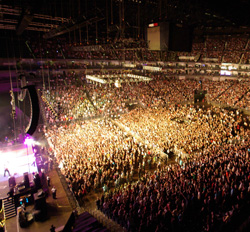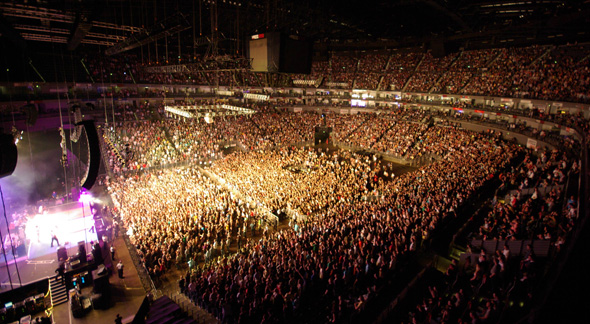The first tour of duty for the new Martin Audio MLA (Multi-Cellular Loudspeaker Array) has been a recently series of concert dates by German hip-hop band Fettes Brot, with the largest venue of the series being the new Lanxess Arena in Cologne.
Europe’s largest and most modern multi-use arena (with a maximum of 18,000 seats) for concert use, Lanxess Arena was configured for an audience of more than 14,000. With hangs of 16 MLA modules per side (and no delays), the system managed to cover a distance of 328 feet, right up to the top bleachers (a height of 118 feet.).
Sound engineer Olli Voges, who has worked with the system throughout the tour, notes that much had been learned about the system since Martin Audio North American-based Technical Training Manage Martyn ‘Ferrit’ Rowe and Complete Audio Owner André Rauhut first took over as systems techs.
Trial and error array design has been replaced by adopting a numerical optimization of the array’s output based on a highly accurate acoustic model.
MLA was designed to minimize the variations in frequency response, sound pressure levels and set-up times from venue to venue – and operate over distances of up to 492 feet.
“We wanted all our shows to be as consistent as possible, night after night, and be able to offer a more accurate predictive analysis of each room by removing the guesswork,” says Martin Audio R&D Director Jason Baird.
With the multi-cellular approach, each cell can be individually addressed by its own DSP (and class D amplification); thus with six cells in each enclosure a 24-box system provides 144 uniquely tuned elements.
“The beauty is that all the complexity of the DSP is under the hood, so it doesn’t impact on the user,” adds Baird.
Because the144 cells that form a typical 24-box hang is too great a number to optimize manually, Martin Audio’s proprietary Display 2.0 system design software automatically calculates FIR DSP filters for each cell and a redundant-ring audio network (U-NET) downloads the settings into each array enclosure.
Martin Audio VU-NET software provides real time control and monitoring of the system.
Aside from its even frequency response and SPL over audience areas, MLA also provides a very high system output (specified as 140 dB peak per cabinet at 1 meter).
Automatic optimization of the array, both physically (splay angles) and electronically (DSP); computer control and monitoring of the entire system, and total control of the sound system.
Additional features include 90-degree x 7.5-degree dispersion; a compact size (45 inches wide x 14.6 inches high x 26.5 inches deep), one-box-fits-all (festivals to theaters) application range and a global voltage, power factor corrected power supply.
The system also includes an MLX powered, flyable subwoofer capable of an unprecedented peak output of 150 dB at 1meter, an MLD downfill cabinet and Merlin 4-in/10-out system controller and network hub. Audio input is via analog, AES3 or proprietary U-NET.
All of which left Voges reflecting contentedly on his good fortune at meeting with André Rauhut, on the stand of Martin Audio distributors, Atlantic Audio, at this year’s Frankfurt Pro Light+Sound Show.
“At that time we were looking for something that could adapt well to arenas ranging from 2,000-9,000 seats,” he said. “Lanxess Arena was not in the picture then.”
With Rowe taking on the duties of system tech, Voges observed that the system sounded “absolutely beautiful” from the get-go.
Find out more about the Martin Audio MLA system here.





















